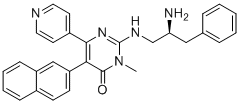
AMG-548
CAS No. 864249-60-5
AMG-548 ( AMG548 )
产品货号. M16264 CAS No. 864249-60-5
AMG-548 是一种有效的选择性 p38α 抑制剂,Ki 为 0.5 nM,对 p38β 表现出弱抑制作用 (Ki=3.6 nM),选择性比 p38γ 和 p38δ 高 5,000 倍以上;与其他 36 种激酶相比,选择性高出 1,000 倍以上,并且对急性和慢性关节炎模型有效。类风湿性关节炎停产
纯度: >98% (HPLC)
 COA
COA
 Datasheet
Datasheet
 HNMR
HNMR
 HPLC
HPLC
 MSDS
MSDS
 Handing Instructions
Handing Instructions
| 规格 | 价格/人民币 | 库存 | 数量 |
| 5MG | ¥7857 | 有现货 |


|
| 50MG | ¥16038 | 有现货 |


|
| 100MG | ¥20250 | 有现货 |


|
| 200MG | 获取报价 | 有现货 |


|
| 500MG | 获取报价 | 有现货 |


|
| 1G | 获取报价 | 有现货 |


|
生物学信息
-
产品名称AMG-548
-
注意事项本公司产品仅用于科研实验,不得用于人体或动物的临床与诊断
-
产品简述AMG-548 是一种有效的选择性 p38α 抑制剂,Ki 为 0.5 nM,对 p38β 表现出弱抑制作用 (Ki=3.6 nM),选择性比 p38γ 和 p38δ 高 5,000 倍以上;与其他 36 种激酶相比,选择性高出 1,000 倍以上,并且对急性和慢性关节炎模型有效。类风湿性关节炎停产
-
产品描述AMG-548 is a potent and selective inhibitor of p38α with Ki of 0.5 nM, dispalys weak inhibition for p38β (Ki=3.6 nM), and >5,000-fold selectivity over p38γ and p38δ; shows >1,000-fold selectivity over other 36 kinases, and is efficacious in acute and chronic models of arthritis. Rheumatoid Arthritis Discontinued.
-
体外实验AMG-548 shows >1000 fold selective against p38γ (Ki=2600 nM) and p38δ (ki=4100 nM). AMG-548 has an modest selectivity against JNK2 (ki=39 nM) and JNK3 (ki=61 nM). AMG-548 is also extremely potent in the inhibition of whole blood LPS stimulated TNFa (IC50=3 nM) and IL1b (IC50=7 nM) as well as TNFa induced IL-8 (IC50=0.7 nM) and IL-1b induced IL-6 (IC5050=1.3 nM) in human whole blood. AMG-548 (10 μM) inhibits the hDvl2 shift.
-
体内实验AMG-548 has rat F of 62% and dog F of 47%. The t1/2 is 4.6 hours in rats and 7.3 hours in dogs.
-
同义词AMG548
-
通路MAPK/ERK Signaling
-
靶点p38 MAPK
-
受体p38 MAPK
-
研究领域Inflammation/Immunology
-
适应症Rheumatoid Arthritis
化学信息
-
CAS Number864249-60-5
-
分子量461.569
-
分子式C29H27N5O
-
纯度>98% (HPLC)
-
溶解度——
-
SMILESCn1c(=O)c(c(nc1NC[C@H](Cc2ccccc2)N)c3ccncc3)c4ccc5ccccc5c4
-
化学全称2-[[(2S)-2-Amino-3-phenylpropyl]amino]-3-methyl-5-(2-naphthalenyl)-6-(4-pyridinyl)-4(3H)-pyrimidinone
运输与储存
-
储存条件(-20℃)
-
运输条件With Ice Pack
-
稳定性≥ 2 years
参考文献
1. Verkaar F, et al. Chem Biol. 2011 Apr 22;18(4):485-94.
2. Lee MR, et al. Curr Med Chem. 2005;12(25):2979-94.
3. Dominguez C, et al. Curr Opin Drug Discov Devel. 2005 Jul;8(4):421-30.
产品手册




关联产品
-
SM1-71
SM1-71 是一种有效的 TAK1 抑制剂,Ki 值为 160 nM,同时可以共价抑制 MKNK2、MAP2K1/2/3/4/6/7、GAK、AAK1、BMP2K、MAP3K7、MAPKAPK5、GSK3A/B、MAPK1/3、SRC、YES1、FGFR1、ZAK (MLTK)、MAP3K1、LIMK1 和 RSK2。SM1-71 在体外抑制多种癌细胞系的增殖。
-
EO-1606
EO-1606 is a p38MAP kinase inhibitor with anti-inflammatory activity and may be used in studies of Alzheimer;s disease and dermatitis.
-
SB 203580
一种特异性p38 MAPK抑制剂,IC50为0.6 uM;显示出对 JNK、p42 MAPK、p90 S6K、p70 S6K、PKA 等的选择性。



 021-51111890
021-51111890 购物车()
购物车()
 sales@molnova.cn
sales@molnova.cn







